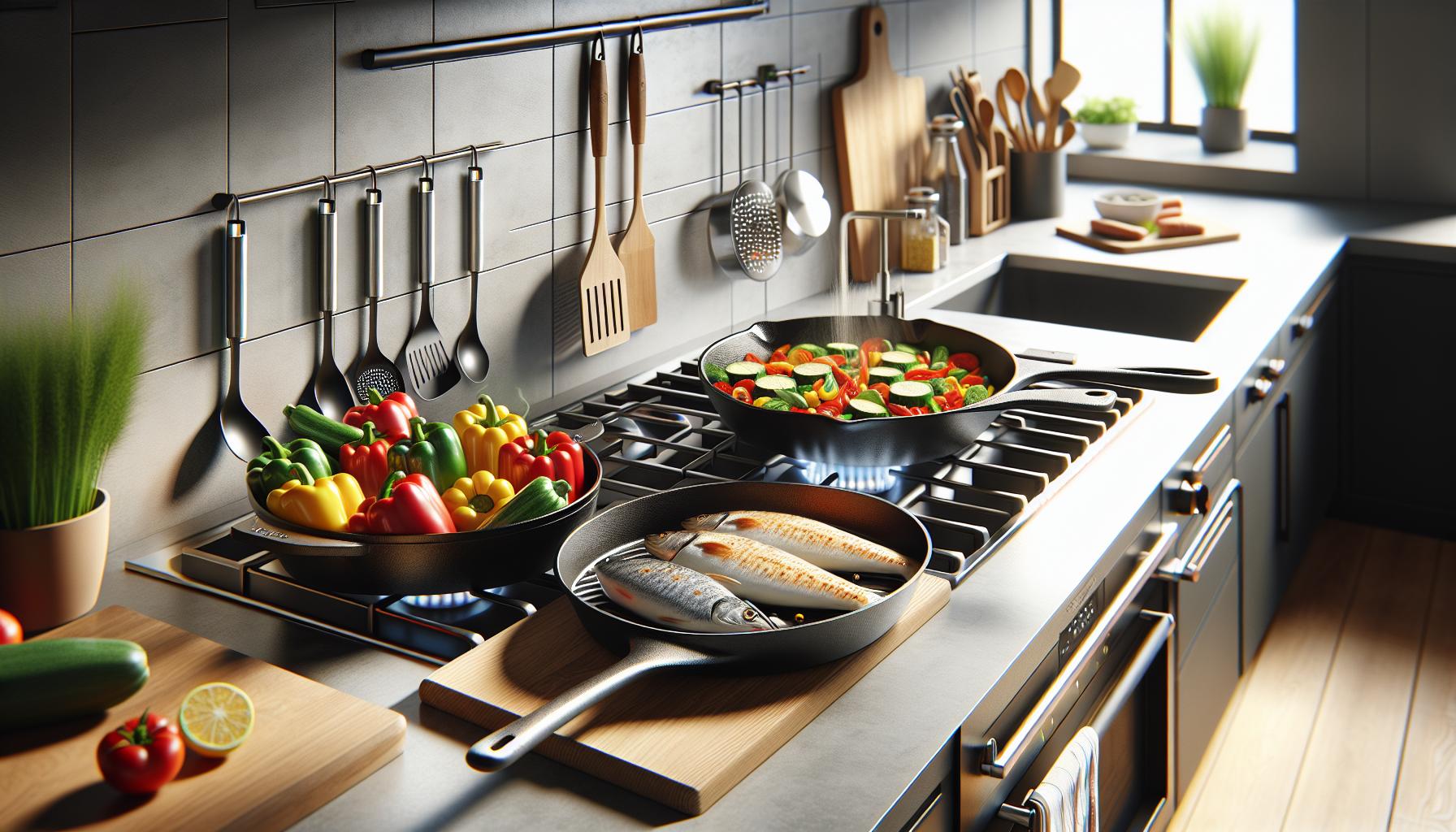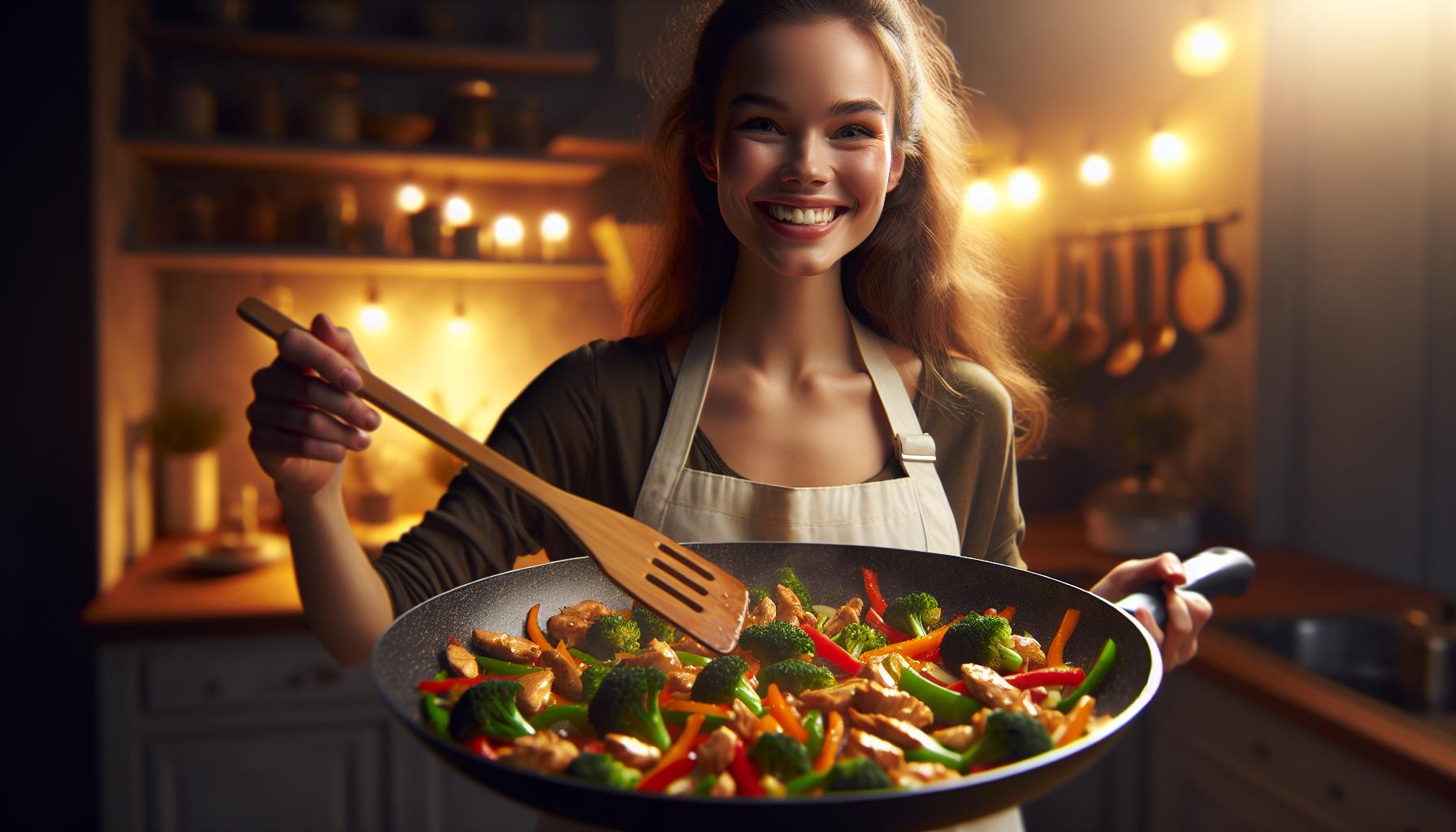Tired of washing a mountain of dishes after cooking? A skillet might just be your new best friend in the kitchen. This versatile pan isn’t just for frying eggs anymore – it’s become the go-to tool for creating delicious and nutritious one-pan meals that’ll make your taste buds dance.
From colorful vegetable stir-fries to lean protein-packed dinners healthy skillet recipes have revolutionized the way people cook at home. They’re perfect for busy professionals meal-prep enthusiasts and anyone who wants to whip up a wholesome dinner without turning their kitchen into a disaster zone. Plus with the right ingredients and techniques these recipes can transform ordinary ingredients into extraordinary meals that’ll have everyone asking for seconds.
What Makes a Skillet Recipe Healthy
Healthy skillet recipes combine nutrient-dense ingredients with efficient cooking methods. Understanding these key elements creates the foundation for nutritious one-pan meals.
Choosing the Right Ingredients
Lean proteins form the cornerstone of healthy skillet recipes, including chicken breast, fish fillets or tofu. Fresh vegetables add essential vitamins, minerals and fiber—examples include bell peppers, broccoli, spinach or mushrooms. Here’s a breakdown of recommended ingredient portions:
| Ingredient Type | Portion Size | Benefits |
|---|---|---|
| Lean Protein | 4-6 oz | 20-25g protein |
| Vegetables | 2-3 cups | 4-6g fiber |
| Healthy Fats | 1-2 tbsp | Omega-3 acids |
| Whole Grains | 1/2 cup | Complex carbs |
- Start with firm vegetables like carrots or Brussels sprouts
- Add medium-density items like bell peppers or zucchini
- Finish with quick-cooking greens like spinach or kale
- Use minimal oil through spray application or measured portions
- Steam ingredients by adding small amounts of broth or water
- Monitor cooking times to maintain texture and nutritional value
Essential Equipment for Healthy Skillet Cooking

Creating healthy skillet recipes requires specific equipment that enhances cooking efficiency and food quality. The right tools make a significant difference in achieving consistent results across various recipes.
Best Types of Skillets to Use
Cast iron skillets deliver superior heat distribution and natural non-stick properties when properly seasoned. A 12-inch cast iron skillet accommodates meals for 3-4 people while a 10-inch version suits 1-2 servings. Stainless steel skillets with aluminum cores provide excellent temperature control for delicate proteins like fish or chicken breast. Carbon steel skillets combine the benefits of cast iron with lighter weight making them ideal for sautéing vegetables or stir-frying.
| Skillet Type | Best Uses | Heat Capacity |
|---|---|---|
| Cast Iron | High-heat cooking, searing | Up to 500°F |
| Stainless Steel | Acidic foods, sauce-based dishes | Up to 400°F |
| Carbon Steel | Quick-cooking, stir-frying | Up to 450°F |
Must-Have Kitchen Tools
A high-quality silicone spatula protects non-stick surfaces during cooking. Metal tongs enable precise ingredient placement and turning. A heat-resistant digital thermometer ensures proper cooking temperatures for proteins. Kitchen scales measure ingredients accurately for portion control. Measuring spoons maintain consistency in seasoning amounts. Microplane graters add fresh aromatics like garlic or ginger. Glass measuring cups portion liquids precisely. Heat-resistant oven mitts protect hands when transferring hot skillets.
| Essential Tool | Primary Function |
|---|---|
| Silicone Spatula | Gentle stirring |
| Metal Tongs | Ingredient handling |
| Digital Thermometer | Temperature monitoring |
| Kitchen Scale | Portion control |
Quick and Light Skillet Breakfast Ideas
Starting the day with a nutritious skillet breakfast sets the foundation for sustained energy levels. These protein-rich options pack essential nutrients into one convenient pan.
High-Protein Morning Scrambles
A protein-packed scramble combines 3 large eggs with lean turkey sausage crumbles, diced bell peppers, mushrooms and spinach. Adding cottage cheese boosts the protein content to 25g per serving while creating a creamy texture. Seasoning with fresh herbs like chives, basil or dill enhances flavor without excess sodium. The entire dish cooks in under 10 minutes using medium heat.
| Ingredient | Protein (g) | Cooking Time |
|---|---|---|
| Eggs (3) | 18g | 3-4 min |
| Turkey Sausage (2oz) | 14g | 4-5 min |
| Cottage Cheese (1/4 cup) | 7g | N/A |
Vegetable-Packed Frittatas
Frittatas transform basic ingredients into an elegant breakfast option. Starting with 6 beaten eggs, layer sautéed vegetables like asparagus, cherry tomatoes and zucchini directly in the skillet. Sprinkle 1/4 cup of feta cheese and fresh herbs before transferring to a 375°F oven. The frittata bakes for 12 minutes until set but still creamy in the center.
| Vegetable Mix | Cooking Method | Time |
|---|---|---|
| Hard Vegetables | Sauté first | 5-6 min |
| Leafy Greens | Add last | 1-2 min |
| Eggs + Cheese | Oven bake | 12 min |
Lean Protein Skillet Dinners
Lean protein skillet dinners combine nutritious ingredients with simple cooking techniques for flavor-packed meals. These recipes maximize protein content while minimizing unnecessary fats through efficient one-pan cooking methods.
Chicken and Turkey Recipes
Chicken breast transforms into tender skillet meals through proper temperature control at 375°F. A 3-minute sear creates a golden crust on skinless turkey cutlets while retaining moisture. Adding aromatics like garlic scapes garlic powder rosemary enhances flavor without extra calories. Popular combinations include:
- Mediterranean chicken with cherry tomatoes zucchini oregano
- Turkey fajita skillets with bell peppers onions lime juice
- Garlic herb chicken with mushrooms spinach white wine
- Asian-inspired turkey with snap peas carrots ginger
These lean poultry proteins cook in 12-15 minutes when cut into 1-inch pieces.
Fish and Seafood Options
Fresh seafood cooks quickly in a preheated skillet at 400°F for optimal texture. Salmon fillets develop crispy skin in 4 minutes per side while staying tender inside. Essential seasoning combinations include:
- Lemon herb cod with capers parsley white wine
- Blackened tilapia with cajun spices lime wedges
- Garlic shrimp scampi with cherry tomatoes basil
- Asian glazed salmon with bok choy sesame seeds
Fish fillets require 3-5 minutes per side depending on thickness. Shellfish like shrimp cook in 2-3 minutes total when peeled deveined.
One-Pan Vegetarian Skillet Meals
Vegetarian skillet meals combine plant-based proteins with fresh vegetables for complete nutrition in a single pan. These recipes maximize flavor while minimizing cleanup time.
Mediterranean-Style Dishes
Mediterranean skillet meals incorporate classic ingredients like eggplant, tomatoes, chickpeas, olives for authentic flavor profiles. A ratatouille-style skillet combines diced eggplant, zucchini, bell peppers in a rich tomato sauce seasoned with herbs de Provence. Greek-inspired skillets feature pearl couscous, roasted red peppers, artichoke hearts topped with crumbled feta cheese. Popular combinations include:
- Tuscan white bean skillet with kale, sun-dried tomatoes, garlic
- Mediterranean quinoa with roasted vegetables, olives, fresh herbs
- Chickpea shakshuka with bell peppers, onions, spiced tomato sauce
- Eggplant caponata with capers, pine nuts, fresh basil
- Crispy tofu with broccoli, carrots, snap peas in teriyaki sauce
- Black beans with sweet potatoes, kale, chipotle seasonings
- Lentils with mushrooms, spinach, caramelized onions
- Tempeh with quinoa, roasted vegetables, tahini drizzle
| Protein Source | Grams per Cup | Cooking Time |
|---|---|---|
| Black Beans | 15g | 5-7 minutes |
| Tempeh | 31g | 8-10 minutes |
| Firm Tofu | 20g | 6-8 minutes |
| Lentils | 18g | 12-15 minutes |
Tips for Reducing Oil and Fat
Creating healthier skillet meals starts with minimizing excess oil and fat while maintaining flavor and texture. These proven techniques enhance nutritional value without compromising taste.
Healthy Substitutions
Vegetable broth replaces oil for sautéing vegetables, creating a flavorful base with zero added fats. Pureed fruits like applesauce or mashed bananas substitute for oil in baked skillet recipes, reducing calories by 75%. A mixture of Greek yogurt with herbs serves as a creamy sauce alternative, providing protein while cutting saturated fat. Here’s a comparison of common substitutions:
| Ingredient | Healthy Alternative | Calorie Reduction |
|---|---|---|
| Butter (1 tbsp) | Applesauce (1 tbsp) | 102 calories |
| Heavy Cream | Greek Yogurt | 180 calories/cup |
| Cooking Oil | Vegetable Broth | 120 calories/tbsp |
- Heat skillet before adding ingredients
- Use proper temperature control
- Apply cooking spray sparingly
- Maintain seasoned cookware
- Utilize silicon-based tools
Conclusion
Healthy skillet recipes offer an ideal solution for anyone looking to create nutritious meals without sacrificing flavor or spending hours in the kitchen. From protein-packed breakfasts to vegetarian dinners these versatile one-pan dishes make it easy to maintain a balanced diet while minimizing cleanup time.
With the right techniques proper tools and smart ingredient choices anyone can transform their skillet into a powerhouse for healthy cooking. Whether it’s reducing oil experimenting with plant-based proteins or creating quick weeknight dinners the possibilities are endless. These recipes prove that healthy eating doesn’t have to be complicated or time-consuming – it just takes one good skillet and some culinary creativity.

